Camel Ride of the Three Wise Men, Prague
Prague traffic jam could have almost any cause. Once a year, the traffic in the center stops to let a three-man camel caravan through. It’s perhaps the only day you can encounter a camel in the streets of the Czech capital. Yes, even here in the country that usually ranks at the very top of the most atheistic places in the world rankings, we somehow respect Epiphany. In the countryside, foot processions of the three go house to house, marking the main doors with the wise men’s initials in chalk—a habit believed to have originated from Jewish traditions. In Prague, we have our own fancy version of this camel procession.
Je spousta věcí, které mohou v Praze způsobit dopravní zácpu. Jednou do roka ji má na svědomí tříčlenná karavana na velbloudech. A je to asi jediný den v roce, kdy se v pražských ulicích procházejí velbloudi. Ano, i u nás se slaví epifanie. Zatímco na venkově chodí koledníci, kteří píší křídou na dveře křesťanů iniciály třech králů, což je zřejmě variace na staré židovské tradice, v Praze se to dělá ve velkém stylu. Tři králové jedou na velbloudech.
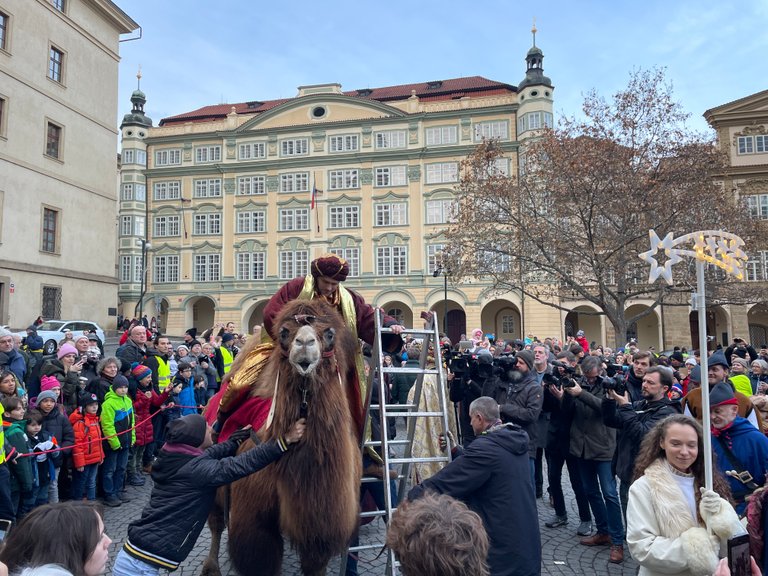

The procession follows the Royal Route (I covered it a month ago here) in reverse, starting at Lesser Town Square underneath Prague Castle and finishing at the Old Town Square. I'm no expert on mounting camels, but I believe the original Wise Men could handle it without a ladder.
Karavana prochází Královskou cestou, o které jsem tu psal asi měsíc zpátky, nej jde v protisměru. Začíná na Malostranském náměstí a končí na náměstí Staroměstském. Osedlávání velbloudů sice nerozumím, ale něco mi říká, že původní Tři králové se obešli i bez žebříků.
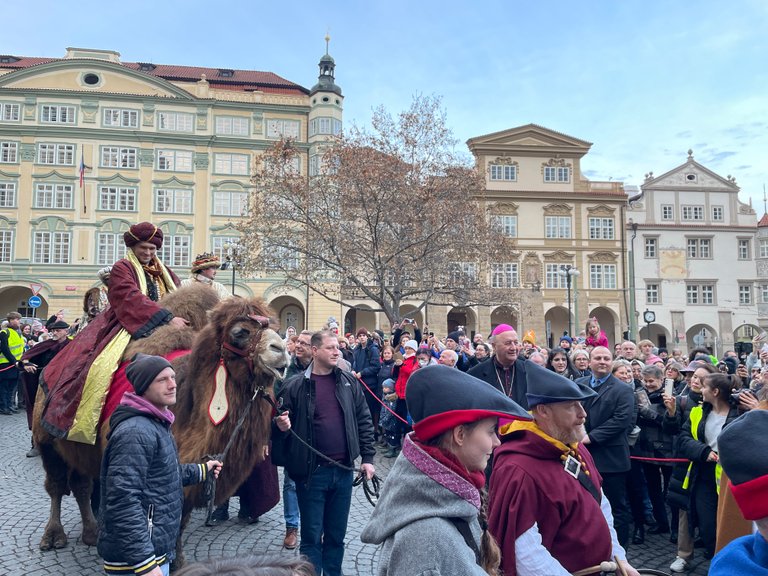
The event is organized by the Catholic Church, the most influential among the relatively weak Czech churches, with approximately 25% of the population claiming affinity to it. Following a brief blessing by the Archbishop of Prague, the caravan hit the road—or rather the narrow cobbled street leading from the square to the Charles Bridge.
Průvod pořádá katolická církev. A tak se po krátkém požehnání od pražského arcibiskupa vydala karavana na cestu směrem ke Karlovu mostu.
In our tradition, the kings are Kašpar, Baltazar, and Melichar, respectively. The last one is supposed to be a black man. However, in a central European country that had no historical connections to Africa for centuries, spent a significant part of the 20th century isolated in the Eastern Bloc, and has a language that is unpronounceable and challenging to learn, people of color, particularly those participating in the Catholic church, are absent. Put simply, Melichar has always been portrayed by a white person in blackface.
Kašpar, Melichar, a ten černý vzadu, to je Baltazar. Nám přijde normální, že je to běloch se začerněnou tváří. Ve spoustě jiných zemí je to dneska faux pas. Ale je fakt, že u nás černochů, kteří by uměli česky a angažovali se v katolické církvi, moc nežije.
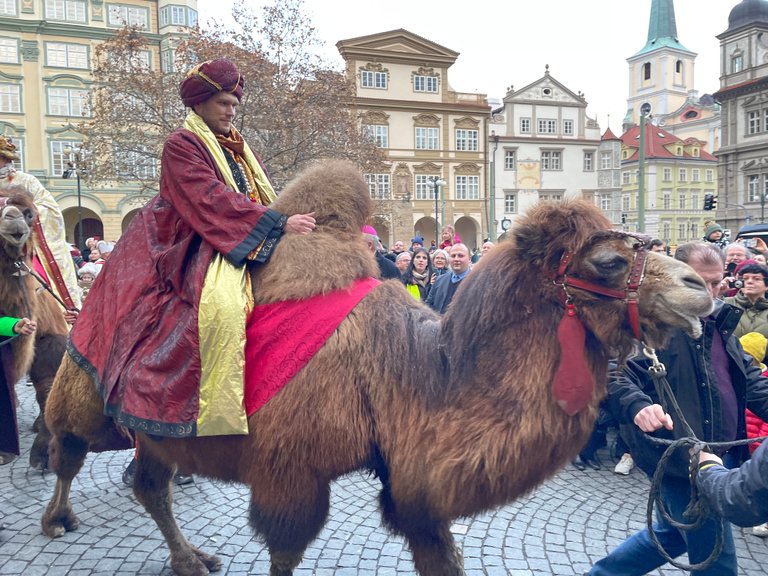
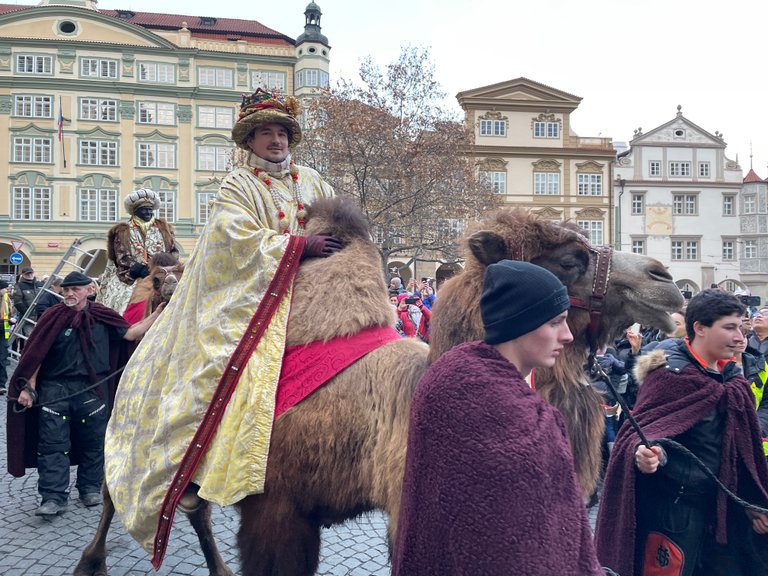
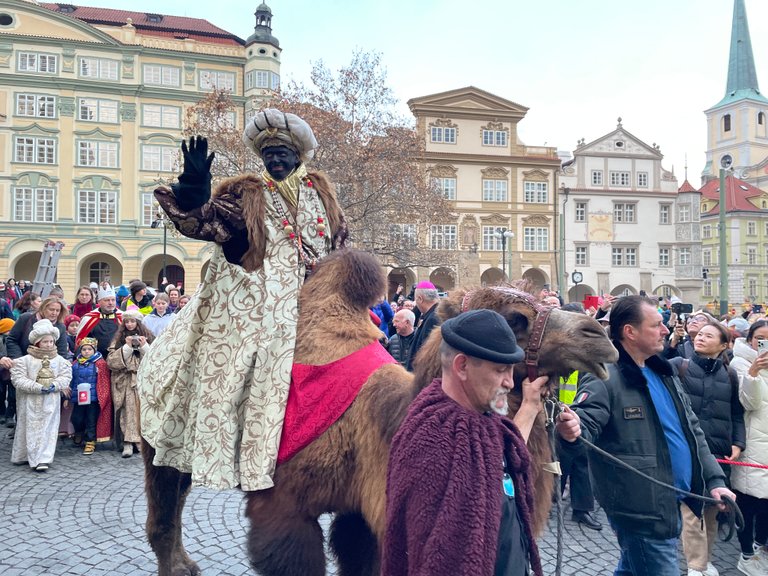
Since the old Prague streets aren't particularly suitable for caravans and such processions, the Three Wise Men almost immediately clogged the first one they entered. The camels didn't help much; they appeared uncomfortable with the crowds and carols played by the musicians in front of the riders. Additionally, they were not pleased with the slow pace. The caravan had to make several stops along the way so that the leading camel, named Achab, could be calmed down by his herder.
Uličky staré Prahy nejsou pro karavany a jiná procesí optimální, a tak Tři králové prakticky okamžitě ucpali Mosteckou. Velbloudi situaci moc nepomáhali, přišlo mi, že se jim atmosféra kolem ani bubeníci a muzikanti moc nezamlouvají. Pomalé tempo asi taky nebyl jejich šále čaje. Karavana musela několikrát zastavit, aby mohl chovatel uklidnit Achaba, prvního z velbloudů.


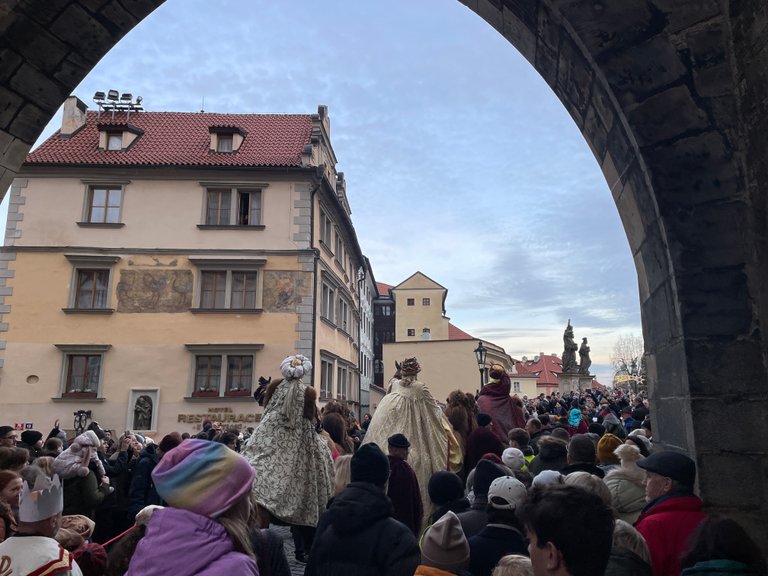
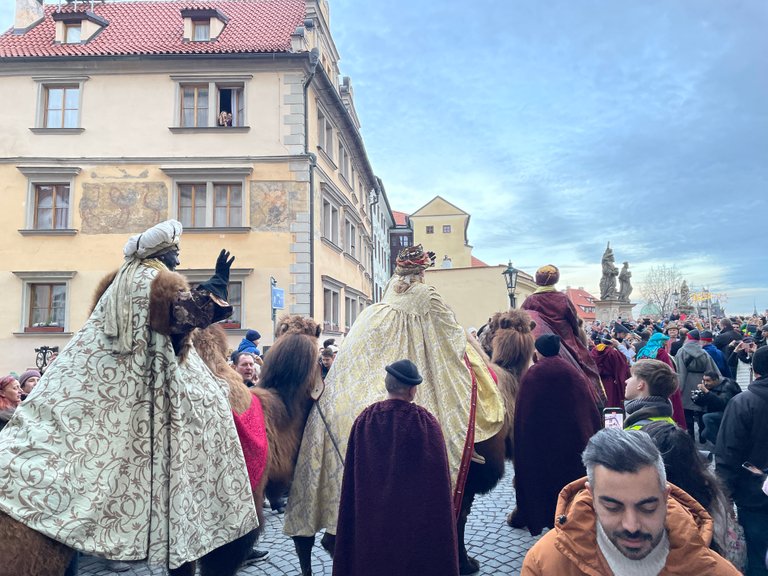

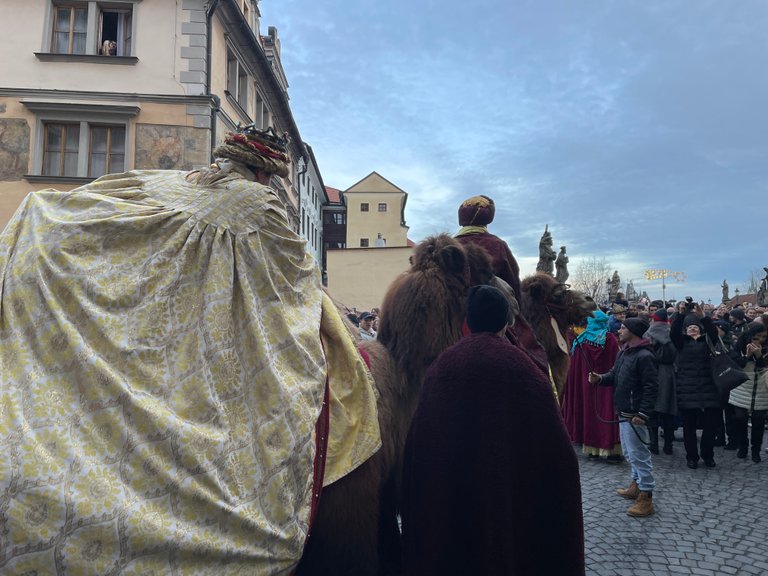
When the caravan finally reached the bridge, I took advantage of my local knowledge to overtake it. The Charles Bridge has several side staircases, and I departed using a hidden one near the Lesser Town Bridge Tower in the pictures. I re-entered the bridge near Čertovka Stream, a hundred meters further. Thanks to that maneuver, I bypassed the crowds and could capture some nice shots. Even those with the Prague Castle in the background.
Když se karavana konečně dostala na Karlům most, využil jsem toho, že na rozdíl od většiny jejích následovníků znám Prahu jako své boty. Tedy kdyby ryby nosily boty. Hned za věží je malé schodiště, kterým se dá seběhnout k Muzeu Karla Zemana. A odtud asi sto metrů na Kampu, kde jsou o poznání známější schody. Takhle jsem se vyhnul davům a měl možnost udělat pár snad povedených fotek s Pražským hradem na pozadí.
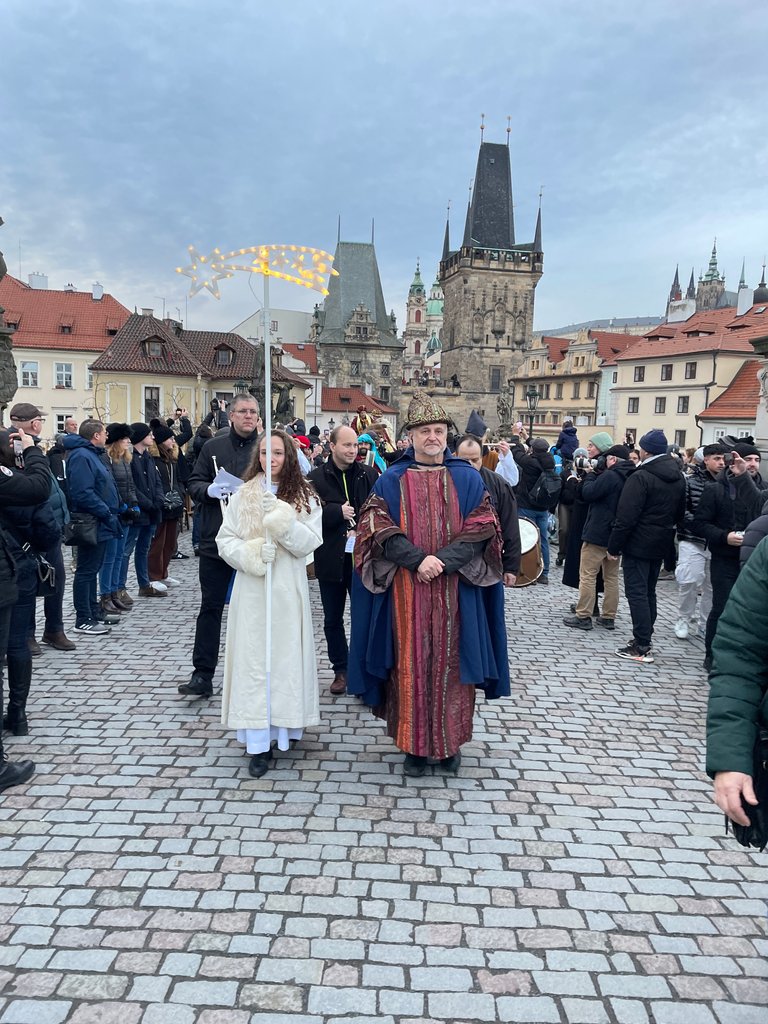
The Star of Bethlehem in the lead.
Betlémská hvězda v čele procesí.
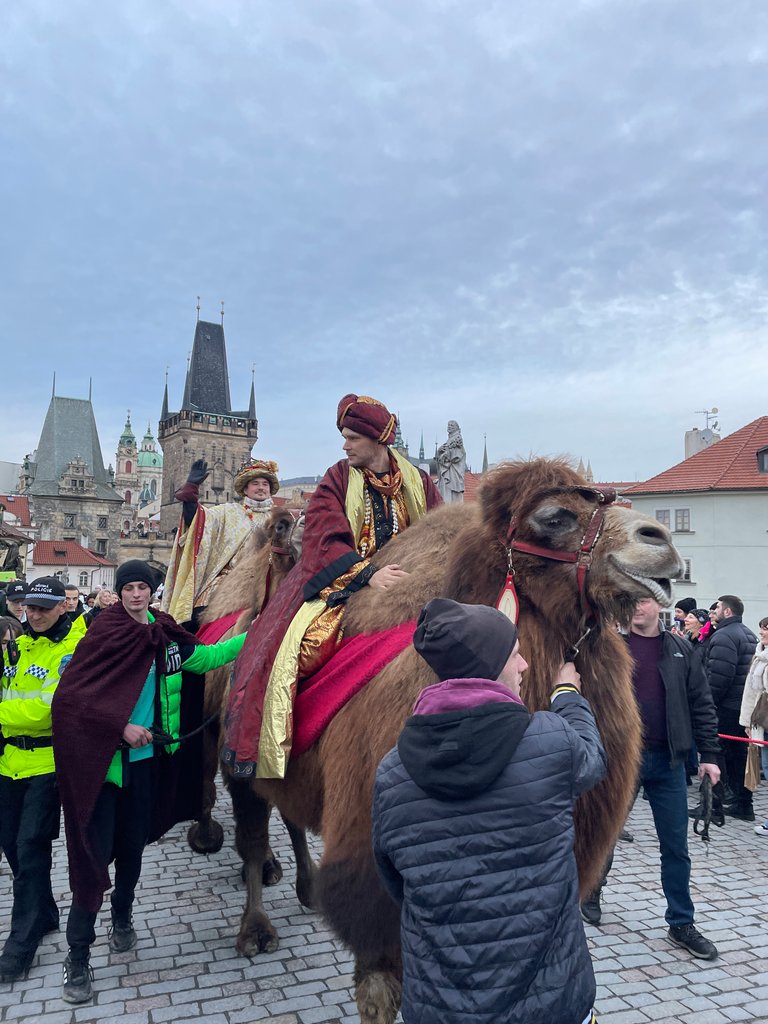
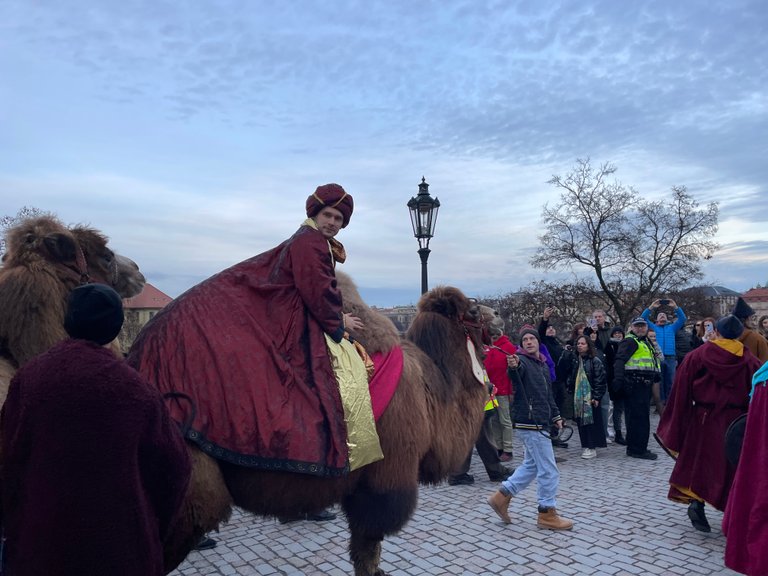


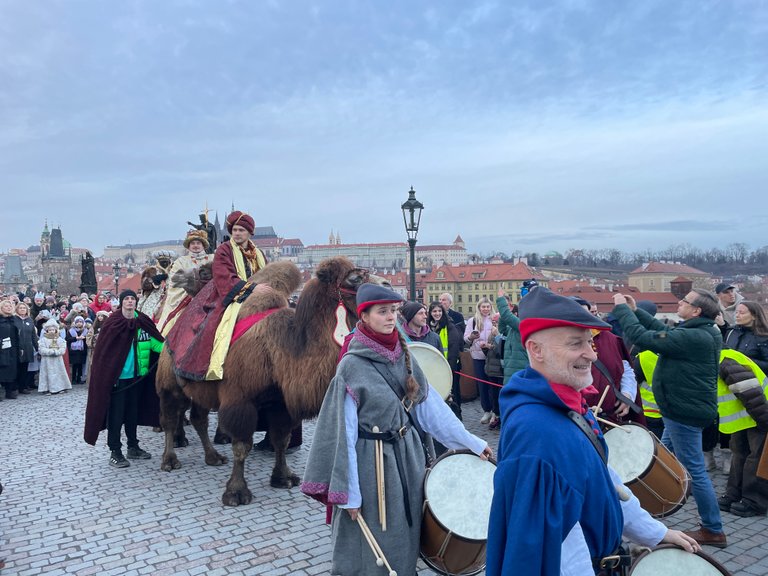
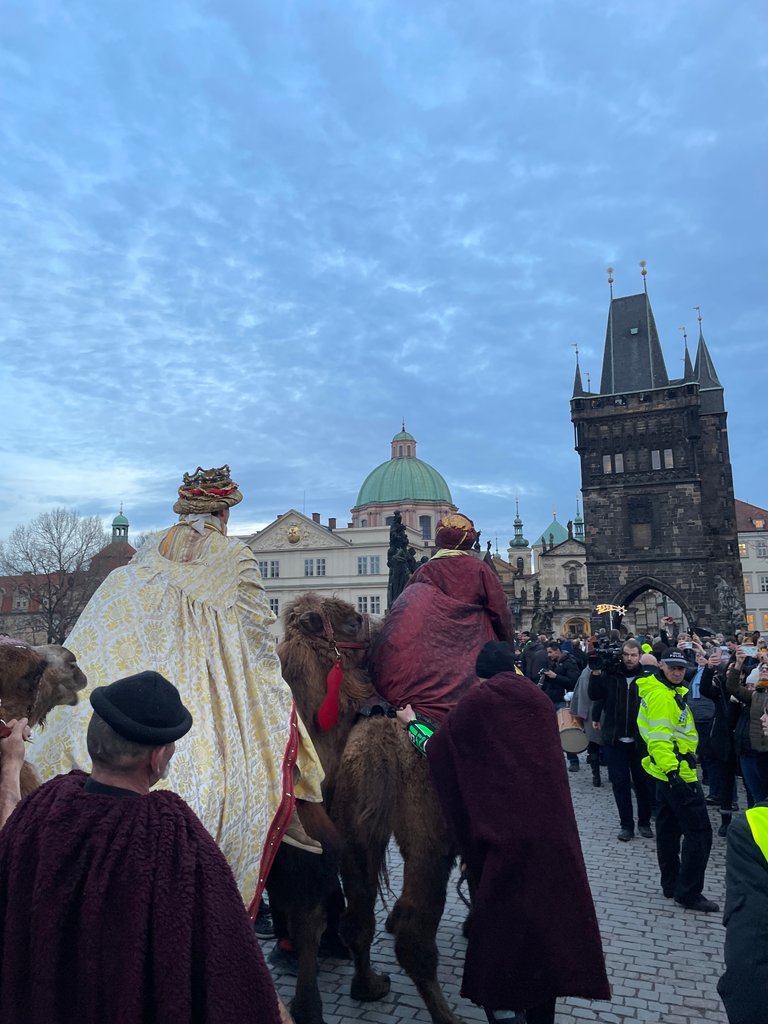



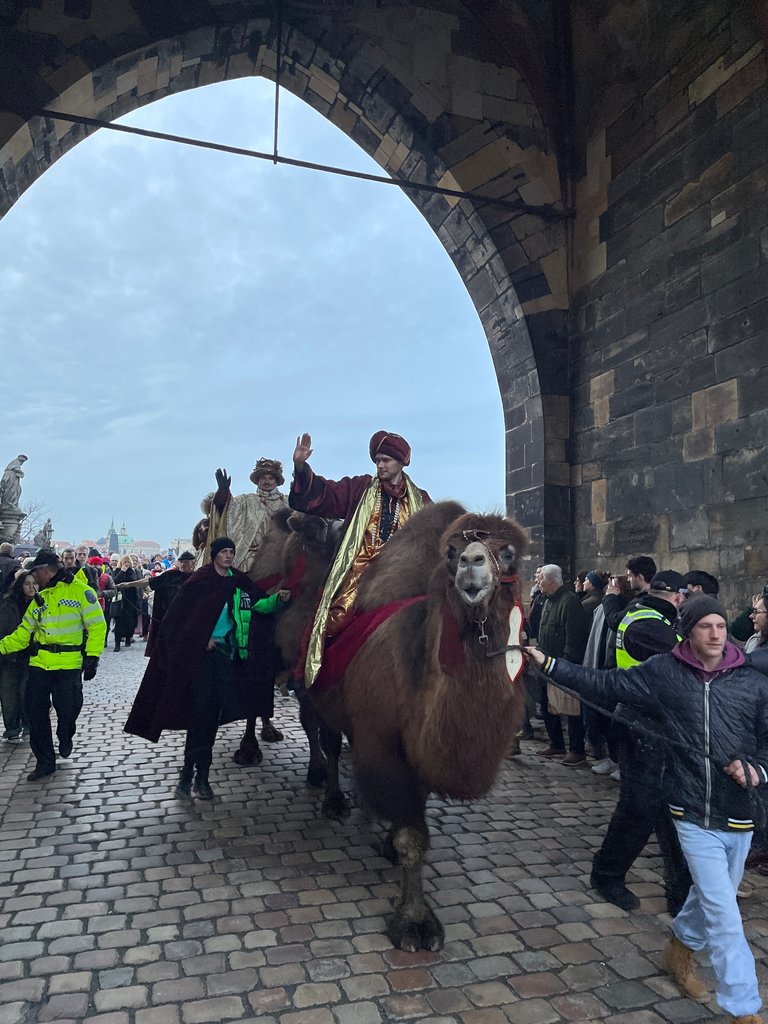
I particularly like this shot. It suggests the Star of Bethlem might had been considering a stop for a Thai massage. Who knows what would happen with the Three Wise Men in Thailand? It's in Karlova Street in the Old Town yet.
Tahle fotka mě baví, Betlémská hvězda možná zvažovala zastávku na thajskou masáž. A kdo ví, co by se se Třemi králi stalo v Thajsku? Fotka je z Karlovy ulice, ze Starého Města.
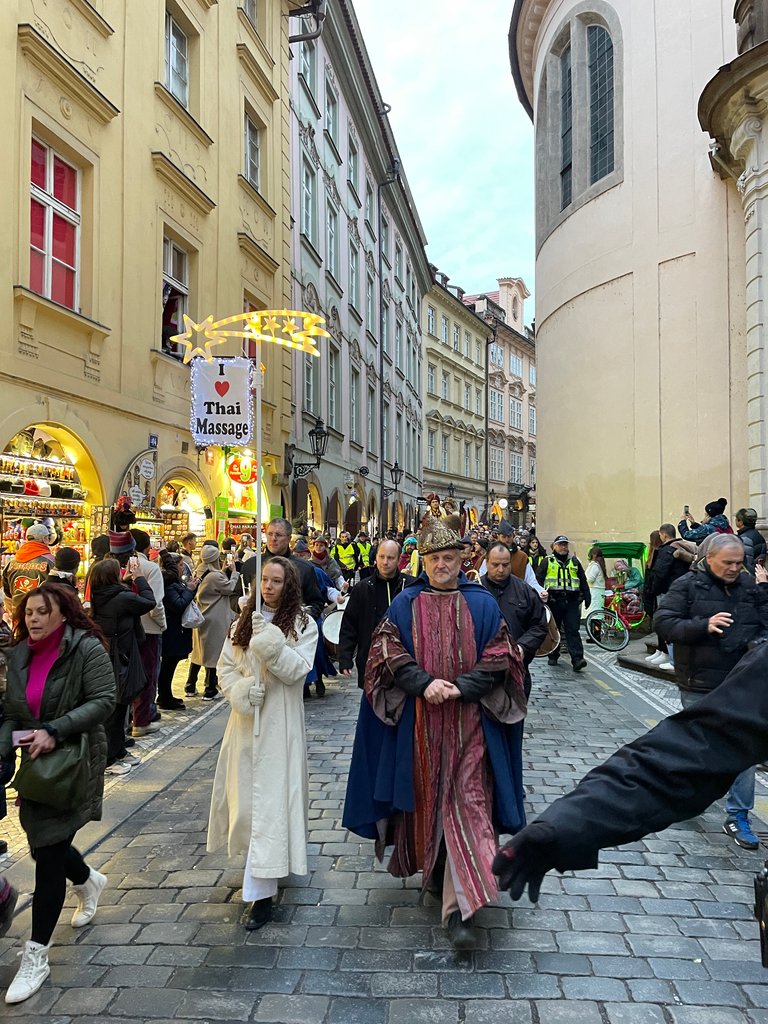
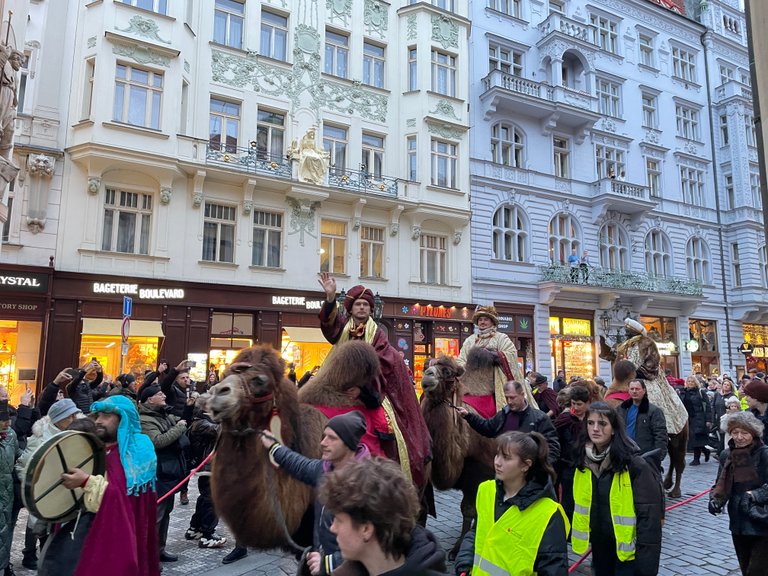

Within several minutes, the caravan reached the Old Town Square with a stage and a couple portraying Mary and Joseph anticipating the arrival of the Three Wise Men. To my surprise, the couple had a real newborn baby, not a doll. Knowing the route, I left the caravan a tad earlier to secure a good spot by the stage. Upon their arrival, the Wise Men were assisted in dismounting their camels, and one by one, they approached Baby Jesus to present their precious gifts as tradition dictates: gold, frankincense, and myrrh. As a Czech, I am sure a huge mistake occurred there—beer is entirely absent from the story!
Během několika dalších minut už karavana dorazila na Staroměstské náměstí, kde bylo připravené pódium, na kterém už na Tři krále čekali Marie s Josefem. Překvapilo mě, že novorozeného Ježíška nehrála panenka, ale opravdové mimino. Protože jsem věděl, kudy asi karavana půjde, včas jsem ji opustil a našel si místo s dobrým výhledem přímo pod pódiem. Tři králové dorazili chvíli po mně, jejich doprovod jim pomohl sesednout z velbloudů a pak už jeden po druhém přinášeli dary Jezulátku přesně tak, jak velí tradice. Zlato, kadidlo a myrhu. Na pivo se opět zapomnělo.

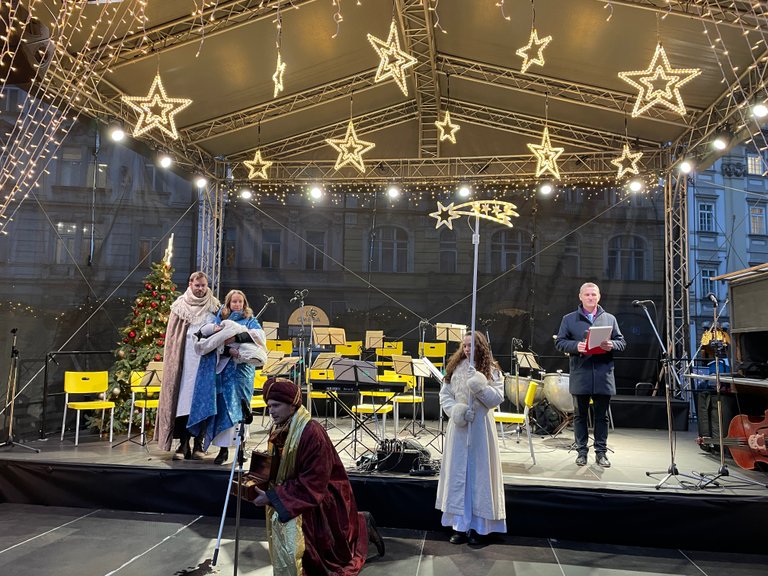

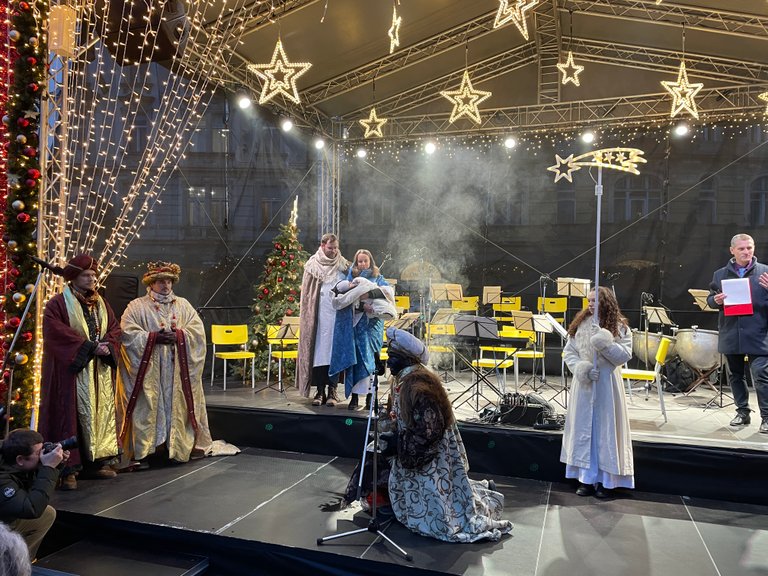

I'm aware that in various countries, including my beloved Spain, Epiphany or the arrival of the Three Wise Men is an important day.
Congratulations, your post has been added to Pinmapple! 🎉🥳🍍
Did you know you have your own profile map?
And every post has their own map too!
Want to have your post on the map too?
Věřím, že se jednou dočkáme doby, kdy se pro lidské potěšení nebudou zneužívat zvířata. A to ani pod záminkou tradic. Zatím je jich ale ve světě pořád až děsivě moc. Tohle zjevně zas taková hrůza nebyla, ale jsem si jistý, že ti velbloudi si to opravdu moc neužili...
Za ty tři nebo čtyři tisíce let už jsou podle mého velbloudi na koexistenci s lidmi zvyklí a taková kilometrová projížďka by je nerozházela, kdyby nebyla na pražských dlažebních kostkách. I ten ruch by pro ně měl být relativně v pohodě.
Špatně snášeli pomalé tempo, šlo se krokem. A taky bezohlednost některých fotografů, kteří kvůli fotce několikrát narušili kordon, který je na fotkách vidět. Opakovaně je museli krotit měšťáci (fotografy, ne velbloudy).
Jak říkám, zrovna v tomto případě to zjevně žádný brutální případ animal abuse nebyl, takže s tvým komentářem víceméně souhlasím. Ale když trochu odbočím, tak pouhá skutečnost, že se něco dělá už dlouho, v mých očích jako obhajoba týrání zvířat neobstojí. Takový Phajaan se taky praktikuje dost možná po staletí a nemyslím si, že by si sloni na to, že je jako mláďata bodají hřebíky a mlátí řetězy, mohli nějak zvyknout. Resp. každý normální člověk musí vidět, že je to naprosto nechutné a zavrženíhodné. A takových "tradic" bychom dodnes našli po světě fakt hodně. Kdysi jsem na to téma psal nějaké články (ne tady ale pro jeden americký populárně-naučný web) a bylo mi z toho fakt smutno a úzko. Mimochodem, jaký má například tvoje T. názor na španělskou koridu?
Na té opravdové nikdy nebyla, to je dneska spíš záležitost Navarry, Katalánska nebo Valencie. A je proti tomu. Byli jsme jen na běhu s býky tři roky zpátky ve Francii. To byl hodně zajímavý zážitek, tedy pokud nejsi v kůži toho býka. I když tam nejde o to býka zranit nebo zabít. Místní honáci na koních převádějí býky z kraje vesnice do arény, takhle, a všichni ostatní se snaží, aby jim býk utekl. Když jim uteče, chvíli se potlouká po vesnici, než ho honáci znovu najdou a dovedou do té arény.
V ní nejsou matadoři ani toreadoři, ale kluci, a dneska už asi i holky, s takovým hřebenem. Naskočí do arény s býkem, hřebenem ho mají sčísnout tak, aby se na něm zachytila alespoň nějaká žíně, a z arény zase vyskočí. Za úspěšný pokus mají bod. Býka to určitě štve, ale neteče při tom krev. Tedy býkům, lidem občas ano. Býka pak nechají uklidnit a normálně se vrací zpátky na farmu. Kde ho tedy asi stejně o něco později porazí na maso, pokud není chovný.
Tohle je video přímo z vesnice, ve které jsme byli:
Vlastně myslím, že je ten běh vesnicí pro býky asi horší než ta arena (těžko říct, třeba pes nebo kočka by to podle mého brali jako super zábavu, ale to jsou šelmy, ne býložravci). Protože když se je podaří osvobodit, máš je chytit a zastavit na místě. Býci mají na rozích takové špunty, aby nemohli nikoho nabrat, ale furt je to hora svalů, která může vážit třeba tunu.
Asi tři vteřiny po téhle fotce se všichni rozprchli, jako když do nich střelí. Včetně mě teda :) Kluci totiž býka naráz pustili, asi na nějaký povel. A ten se oklepal, vstal a vystřelil. Zpětně se divím, že nedošlo k žádnému úrazu.
No, tohle mi přijde taky dost buranská zábava. Ano, fyzicky to tomu býkovi asi nijak zásadně neublíží, ale ten šílený stres, co přitom musí zažívat... Jak říkám, snad se jednou dočkáme doby, kdy se lidi dokážou bavit, aniž by u toho nějaký další tvor musel trpět...
When I was interested in bullfighting in Spain, due to my trip to Spain, I read in the articles that in October 1971 in Belgrade, at the Tasmajdan Stadium, a Bullfight was held for the first time outside of Spain.
I found it interesting that the reporters wrote that the audience mostly cheered for the bulls.
They cheered "Ole", when the matador was losing duels...😃
In the end, no matador was killed. But many bulls were killed 😕
Justice for animals!
When I was interested in bullfighting in Spain, due to my trip to Spain, I read in the articles that in October 1971 in Belgrade, at the Tasmajdan Stadium, a Bullfight was held for the first time outside of Spain.
I found it interesting that the reporters wrote that the audience mostly cheered for the bulls.
They cheered "Ole", when the matador was losing duels...😃
In the end, no matador was killed. But many bulls were killed 😕
Justice for animals!
It is clear that my fellow citizens respected animals 50 years ago... b
Bulls were a measure of the wealth of Serbian peasants before World War II. with a bull in the household, it was guaranteed that the householder would be able to cultivate the land and feed the family, not to kill the bull for fun...
I would cheer for the bulls too if I had to be there but generally, I always try to avoid supporting any business/facility/tradition/whatever that is based on animal abuse. The bulls didn´t want to be in the arena, fighting for life against some crazy humans. They wanted to be at the farm/ranch, living peacefully and doing what bulls are supposed to do. Justice for animals indeed. Thanks for your contribution to the debate :)
Thank you and feliz día de Los Reyes, @godfish 😇
I hope they brought you something special :)
I think I didn't behave well 😬 as I got no gift. Just a sunny and better day, so I guess it also counts 😉
It does, indeed :)
Yes, it is very unexpected to meet a desert dweller in the center of an old European city))) But the camel is very beautiful!
Beautiful procession.
The biggest crowd in the street leading to the bridge from the Mala strana. I remember that street, it is crowded even when there is no parade 😀
I really like the hats worn by the participants in the procession.
Well, that's how we imagine ancient oriental wisemen ;)
Yay! 🤗
Your content has been boosted with Ecency Points, by @godfish.
Use Ecency daily to boost your growth on platform!
Hahah, camels in Prague. Isn't it a bit too cold for them?
!DHEDGE
It was still quite warm compared to nights in desert, as it is usually below zero there ;)
This post has been selected for upvote from our token accounts by @seckorama! Based on your tags you received upvotes from the following account(s):
- @dhedge.bonus
- @dhedge.pob
- @dhedge.neoxag
- @dhedge.waiv
@seckorama has 9 vote calls left today.
Hold 10 or more DHEDGE to unlock daily dividends. Hold 100 or more DHEDGE to unlock thread votes. Calling in our curation accounts currently has a minimum holding requirement of 100 DHEDGE. The more DHEDGE you hold, the higher upvote you can call in. Buy DHEDGE on Tribaldex or earn some daily by joining one of our many delegation pools at app.dhedge.cc.
It seemed quite fun to be there and I saw people riding camels, I have never seen anyone riding a camel like this. Always healthy for you friend and I hope you always have a nice day.
Ha, what a great story this is and told by you with that keen sense of humor...but a real newborn baby...they went overboard on this and didn't get to another issue...the lack of beer thing. 😁
It's up to the parents. I guess it was safe for the baby, and its part took only like twenty minutes. Still, being on stage in front of crowds from all across the globe, since it took place on the most touristy square of touristy Prague, is a huge thing. Who gets famous in the age of like three months?
I am sure beer was constantly censored from the Holy Bible for centuries. In fact, Jesus shared wine as his blood and beer (the true liquid bread) as his body. There's a Holy Hops Church that spreads this evangelium.
Nice 👍 👍 👍 👍 👍
The camel looks very beautiful.
It's just a camel, like any other ;)